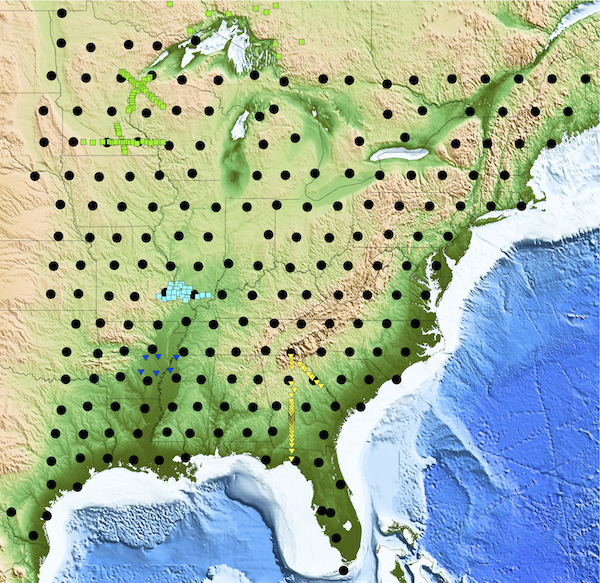2012 IRIS Workshop
Leveraging Asynchronous Dense Deployments -- An Important Benefit from Extending the Operation of "One-in-Four" TA Stations
Ray Willemann: IRIS Consortium, Greg Beroza: Stanford University, Shuo Ma: San Diego State University
Flexible Array experiments SPREE (green), OIINK (cyan), NELE (blue), and SESAME (yellow) are amid Transportable Array stations that might continue to operate as part of the "One-in-Four" initiative (black). High-resolution tomography from those FA experiments could be extended to data from additional stations deployed later using the method of ambient-field Green's functions from asynchronous seismic observations, so long as enough nearby TA stations continue to operate at their original sites.

Full-resolution graphics file in original format: 0001.ps
The Flexible Array pool has enabled more and larger deployments, imaging tectonic features in the Central and Eastern U.S. (CEUS) that were known previously from geologic mapping and sparse geophysical observations. But even with the FA, logistics and funding limit deployments to a fraction of the tectonically interesting targets. More extensive coverage would be possible by making smaller, consecutive deployments. If a reference network operates throughout the sequential deployments, then the method of ambient-field Green's functions from asynchronous seismic observations [Ma and Beroza, 2012] can be used to develop a tomographic model that includes information for all of the station pairs. The "one-in-four" mode of continuing operation at selected TA sites in the CEUS is ideal for this in two ways. First, continued operation at the same sites is necessary to create a single tomographic model from the union of embedded FA experiments and stations deployed later. Second, a grid of continuing TA stations facilitates expansion and linking of higher resolution tomographic models indefinitely -- in principal over all of the one-in-four grid. From Ma and Beroza's [2012] results in California, the grid includes enough reference stations within 600 km from any site. Where Ma and Beroza [2012] tested their method, just six months of data were needed for sufficiently stable Green's functions -- short enough to link research with education. Projects integrated into classes might take advantage of fewer (university-owned?) instruments to extend coverage by each year. Teaching projects might expand the area of a 2D broadband array, add cross-lines at key points of linear arrays, densify deployments hint at important small-scale structures, or ultimately even to link deployments that were originally disjoint. In addition, sequential deployments near earthquake monitoring networks could enhance 3D models, which would improve source parameters computed from the permanent network stations.
For further reading: S. Ma & G. C. Beroza, 2012. Ambient-field Green's functions from asynchronous seismic observations, Geophys. Res. Lett., 39, L06301. doi: 10.1029/2011GL050755
Keywords: ambient_noise_tomography
